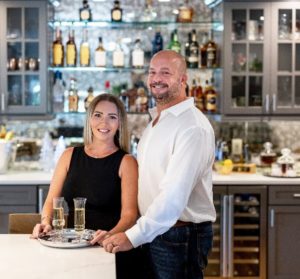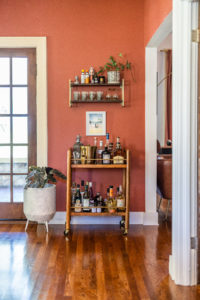
There are two main types of home bar, one being a built-in station, called a “wet bar,” equipped with a sink for washing glasses and which may include an ice maker.
A “dry bar” is much easier to set up and style. It can easily be housed in many different environments or arranged on a bar cart.
In addition to making a stylish statement, bar carts offer plenty of advantages as they don’t take up much space and can be moved from room to room, or even outside, depending on where your gathering is taking place. Bar carts are welcoming enough that guests will feel comfortable walking up and making their own drink. Since most bar carts are open by design, you probably just want to limit it to the basics and keep your less frequently used items in a pantry, so it doesn’t look cluttered.
The surface of any piece of furniture, be it a console table or bookshelf, can easily be transformed into a simple bar. A tray can help to create a defined space and allows you to focus on what essentials you want to have front and center.
Whatever option you choose, a home bar can add a gracious sense of hospitality to your space, no matter the size of your home. After all, a stylish setup is as important as the curated cocktails you will create there.
Here are some tips that may help you become your crowd’s favorite mixologist.
Spirits
Stock your bar with spirits you enjoy, but also splash out and try some things that may be outside of your current favorites list. The best way to make a great cocktail is to develop an appreciation for the drinks you will be mixing.
Here are the basics you will want to have on hand: vodka, gin, light rum, tequila, scotch, bourbon, blended whiskey, dry vermouth, sweet vermouth and triple sec.
The most classic and popular drinks utilize these spirits. One bottle of each will get you started. Liquor is expensive, so start small and build your bar based on the cocktails you enjoy. You don’t have to do it all at once. Accumulate other brands and drink-specific items over time. As far as the exact types or brands of liquor you use, that is up to you —you also probably already know what you like. Buy something decent, but it doesn’t have to be absolutely top-of-the-line. (For example, if someone wants a scotch and soda, don’t use a single malt scotch. That’s alcohol abuse!)
However, if you want to go the extra mile, other spirits you may want to stock would be brandy, cognac, Grand Marnier, crème de menthe (white and green), crème de cacao (dark and white), Drambuie, Amaretto and champagne.
One note on bottle display: premium brands often have eye-appealing labels, so feel free to keep those bottles on display.
Single malt scotches, which come from a single distillery, such as Macallan, Balvenie, Glenmorangie and Lagavulin, are excellent choices.
Keep in mind that all blended scotch contains a certain amount of single malt whisky (as it is spelled in Scotland). A nice choice for an inexpensive scotch is Scoresby, which contains 33 percent single malt, which is a high percentage for a blended scotch.
Single barrel bourbons, which come from a single barrel or cask, such as Blanton’s and Knob Creek, are also excellent choices for bottle display. Other premium bourbon brands would be
Maker’s Mark, Woodford Reserve, Buffalo Trace (a great value for under $30) and Evan Williams (also available in a single barrel version).
Decanters are great for displaying brands of liquors that are not considered premium.
Anything available in a plastic bottle is something you should avoid as plastic contains ethylene glycol and terephthalic acid, which tend to leach when used for storing alcohol over time. If the temperature is high, those chemicals can actually make their way into your drink. So, not only will it change the taste of the drink and reduce the shelf life of the liquor, but it makes toasting to you

r health more of a preemptive strike than a simple social tradition. Spirits in plastic bottles are also more likely to have the type of poor quality distilling components that contribute to hangover symptoms or make a hangover worse. You can do better!
Garnishes
While it may seem like an afterthought, for many the garnish is the crowning touch on a finely prepared cocktail. You will want to have the following on hand: green cocktail olives (pitted and often stuffed with cheese or pimento; Manzanilla is a popular choice), cocktail onions (a small sweet pearl onion pickled in a brine), Maraschino cherries, limes and lemons (used as wedges or as twists) and oranges (to slice or to use the peel, which is sometimes singed for dramatic effect).
Mixers
You will need a variety of sodas necessary for classic cocktails: cola, diet cola, club soda, tonic water and ginger ale, as well as a supply of fresh fruit juices such as orange, lemon, lime, pineapple, tomato, cranberry and grapefruit.
Essential Extras
Drink recipes often call for specific ingredients, including bitters, grenadine, Tabasco sauce, Worcestershire sauce, salt, pepper, sugar and simple syrup.
To make simple syrup, combine equal parts (for example, three cups each) of sugar and water. Bring to a boil, then let cool. Voila: simple syrup!
Bar None
While the primary focus of a home bar is for cocktail creation, not everyone you invite over will necessarily be seeking spirits. Keep a few bottles of your favorite wines on hand, a selection of imported and domestic beer, as well as some non-alcoholic cocktails, so no one feels left out.
Glassware
The way you present your finished cocktail is how many of your guests will judge your final effort and a lot of that comes down to serving it in the right glass. If you want to keep itsimple or slowly build and a cutting board. One of the best sites for contemporary barware is cocktailkingdom.com
Cocktail Recipe Books
These three are must haves: The Craft of the Cocktail by Dale DeGroff, The Joy of Mixology by Gary Regan and The PDT Cocktail Book by Jim Meehan and Chris Call.
If you want to go back in time and see how the professional bartenders of days gone by mixed cocktails, try to get copies of How To Mix Drinks or The Bon-Vivant’s Companion by Jerry “the Professor” Thomas, 1862, or The Savoy Cocktail Book, by Harry Craddock, 1930. Both are out of print, but worth seeking out.

Bartending Tools
While special tools may seem intimidating for bourgeoning cocktail makers, they are absolutely essential and serve a distinct purpose in the drink preparation. We suggest equipping yourself with a shaker set (metal and glass), long cocktail stirring spoon, wine opener, bottle/can opener, cocktail strainer, paring knife, muddler, jigger and a cutting board. One of the best sites for contemporary barware is cocktailkingdom.com
Cocktail Recipe Books
These three are must haves: The Craft of the Cocktail by Dale DeGroff, The Joy of Mixology by Gary Regan and The PDT Cocktail Book by Jim Meehan and Chris Call.
If you want to go back in time and see how the professional bartenders of days gone by mixed cocktails, try to get copies of How To Mix Drinks or The Bon-Vivant’s Companion by Jerry “the Professor” Thomas, 1862, or The Savoy Cocktail Book, by Harry Craddock, 1930. Both are out of print, but worth seeking out.
Extracurricular Reading
Imbibe! by David Wondrich, Bottled Wisdom by Mark Pollman and Cocktails of the Ritz Paris by Colin Peter Field.
Memoirs
For the best memoir of a bartender ever written, read Hemingway’s Paris, by James Charters as told to Morrill Cody.
(Original title: This Must Be the Place). Charters was a bartender in 1920’s Paris. His book is a memoir of his bartending experiences in Paris.
His customers included Ernest Hemingway, F. Scott Fitzgerald, Harpo Marx, James Joyce, Silvia Beach, Gertrude Stein, Sinclair Lewis, Oscar Lewis, etc.
Unfortunately, this is also out of print but, again, worth seeking out.
Films
Some good films with bar/cocktail/drinking scenes include Casablanca, Guys and Dolls, The Seven Year Itch, Where the Buffalo Roam, Fear and Loathing in Las Vegas, Naked Lunch, Bar Fly, The Strawberry Blonde, The Thin Man and Cocktail.
Setting up a home bar can be a fun exercise that will make for more festive times with friends and family members. It can enhance your space, delight your guests and inspire you to try some new things. So, enjoy being a “home bartender” and cheers to you and yours!






